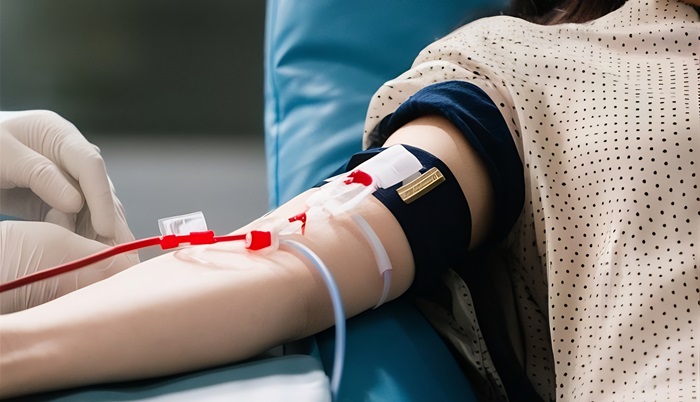Leukemia is a type of blood cancer that is commonly treated with chemotherapy or targeted therapy. However, not all leukemia patients can undergo conventional treatments due to various reasons, such as drug allergies. In such cases, doctors may recommend alternative treatments for leukemia, one of which is apheresis.
Contents
Understanding the Apheresis Procedure
Human blood consists of four main components: red blood cells, white blood cells, platelets, and plasma. In some cases, treating a disease requires the removal or modification of one of these components through a process called apheresis.
Apheresis is a medical procedure that allows doctors to extract or remove red blood cells, white blood cells, platelets, and plasma for treatment. This procedure is also known as pheresis or hemapheresis.
During the procedure, the patient is connected to an intravenous (IV) line, and their blood is drawn into a centrifuge machine. This machine spins the blood to separate its components. Depending on the patient’s condition and medical needs, the extracted blood components can be modified or removed.
While the apheresis machine separates the blood, the patient remains connected to it. The machine continuously spins and separates the blood into components based on density. Red blood cells, being the densest, settle at the bottom, followed by white blood cells, platelets, and plasma.
How Does Apheresis Help Treat Leukemia?
In leukemia patients, there is an excessive increase in white blood cells (leukocytes). Under normal conditions, leukocytes play a crucial role in the immune system. However, when their numbers become abnormally high, they can attack healthy cells and cause various complications.
For leukemia patients, a specific type of apheresis called leukapheresis is performed to remove excess white blood cells. This procedure helps reduce their number in the body, lowering the risk of severe complications.
Leukapheresis is not a one-time procedure. Depending on the patient’s needs and condition, doctors may recommend undergoing apheresis three to four times or even more for optimal results.
Leukapheresis Procedure at Mandaya Royal Hospital Puri
The apheresis procedure is carried out by an internal medicine specialist with expertise in hematology-oncology (Sp.PD-KHOM). At Mandaya Royal Hospital Puri, leukapheresis and other apheresis procedures are performed by Dr. Toman T.J Lumban Toruan, Sp.PD-KHOM.
Dr. Toman has successfully conducted several apheresis procedures, including for leukemia treatment. One patient, for example, had previously undergone chemotherapy but did not respond well due to an allergy to chemotherapy drugs. This is why apheresis was chosen as an alternative treatment.
According to Dr. Toman, the leukemia patient who underwent leukapheresis at Mandaya Royal Hospital Puri showed significant improvement.
“Initially, the patient’s leukocyte count was around 190,000. After just one session of apheresis, it dropped to approximately 90,000. The patient will continue with additional apheresis sessions and other therapies to stabilize their leukocyte levels within a safe range,” explained Dr. Toman.
Consult Our Specialists at Mandaya Royal Hospital Puri
Interested in learning more about apheresis or leukapheresis for leukemia treatment? Do not hesitate to visit Mandaya Royal Hospital Puri and consult directly with our team of medical specialists.
Use our Chat feature via WhatsApp, Book Appointment service, or download the Care Dokter app from Google Play and the App Store to make your visit easier, check queue numbers, and access complete information about our services.



